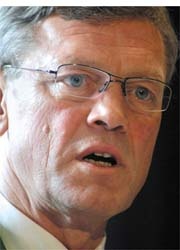Targeting market needs
The hybrid OT meets the needs of modern surgery
In October, the office of the Federal President announced that Professor Haverich, with his Hanover research team, has been nominated for the 'German Future Prize' for the development and successful use of adaptable biological heart valves

Recent developments in surgical techniques, e.g. trans-catheter valve replacement, now promise far better therapeutic possibilities by combining surgery and interventional procedures. The ideal environment for these treatments is the ‘hybrid operating theatre’ (OT), an integrated operating theatre with high-end imaging capabilities for interventions. As a vendor of the highly sophisticated angiography system Artis Zeego, Siemens Healthcare has established a new business unit to focus exclusively on the implementation of Hybrid OTs. The Artis Zeego angiography system is based on robot technology and systems from partner companies, depending on customer needs.
Meike Lerner, of European Hospital, asked Professor Axel Haverich MD, President of the German Society for Thoracic and Cardiovascular Surgery and Director at the Clinic for Heart, Thorax, Transplant and Vascular Surgery at the Medizinische Hochschule Hannover, in Germany (MHH), and Professor Georg Nollert, Director of the new Siemens unit in Erlangen, about this development and its potential.
The technological challenge in hybrid operating theatres lies in setting up a workable imaging system in the theatre that also results in a practical environment for surgeons. ‘Of course, imaging takes up a lot of space and impacts on hygiene requirements for the theatre, so the challenges lie particularly in planning,’ Prof Haverich pointed out.
To tackle planning needs, equipment and applications to meet surgical needs are being developed and tested at the new Siemens unit. ‘Next to Siemens Healthcare with the Artis Zeego we have other manufacturers involved in our hybrid operating theatre business, for example, those that produce operating theatre equipment that we cannot offer,’ Prof Nollert explained. These, he added, are not competitors but partners, who contribute their experience to develop the best solution for customers. Prof Haverich, for example, has been working with a new hybrid solution for four months. ‘We are talking about an outstanding set-up, particularly for the patient, because he benefits from receiving a surgical result that has been constantly controlled during the intervention,’ he said. ‘Thanks to integrated imaging, the patient is often spared a further intervention. For example, with aortic aneurysms we had to carry out surgery but were only able to check results afterwards. Today, this is a minimally invasive intervention and the stent is directly navigated, so that the result is optimal.’
Hybrid operating theatres will also play a significant part in aortic valve insertion, with valves fitted via a small chest incision. ‘We are due to start the procedure in Hanover in a few months – we think it is very promising,’ Prof Haverich prophesised.
On the subject of radiation exposure, he explained that examination times have been considerably minimised by up-to-date technology and that radiation intensity would be no more than for angiography in a cath lab. ‘The point is, we can now combine the surgery with the respective imaging procedure.’
As for future product developments, Prof Nollert mentioned even more specific applications for cardiac surgery that will make procedures such as valve replacements even easier. Other future options include implant ‘libraries’, each to be custom-fitted in the aorta. Another objective for imaging is the conversion to 3-D imaging, which, said Prof Haverich ‘…is very important for us; it would lead to more safety. After all, we operate in a three-dimensional space.’
The costs of a complete solution such as this can be offset against the number of operations saved, shorter aftercare and therefore shorter hospital stays and, above all, lower risks for patients. All of which makes hybrid solutions – currently much in demand in Europe, the USA and Asia — successful. On this, the professors agreed: ‘Imaging is moving into the operating theatre; it is definitely the trend for the future.’
29.10.2008











